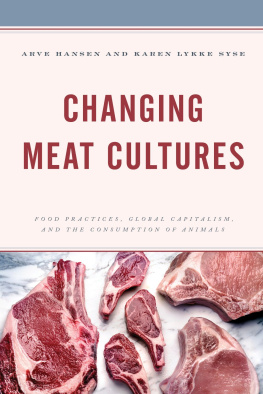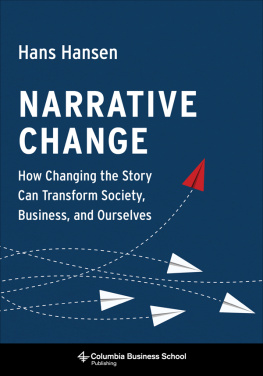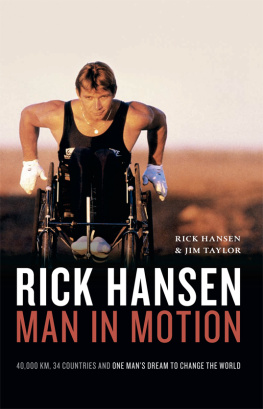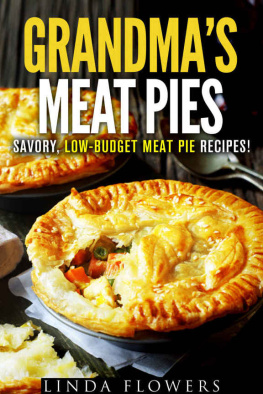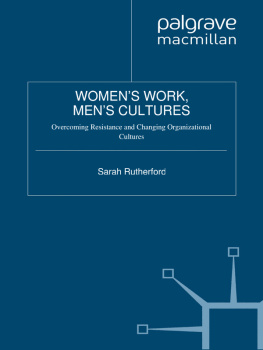Arve Hansen - Changing Meat Cultures
Here you can read online Arve Hansen - Changing Meat Cultures full text of the book (entire story) in english for free. Download pdf and epub, get meaning, cover and reviews about this ebook. year: 2021, publisher: Rowman & Littlefield Publishing, genre: Politics. Description of the work, (preface) as well as reviews are available. Best literature library LitArk.com created for fans of good reading and offers a wide selection of genres:
Romance novel
Science fiction
Adventure
Detective
Science
History
Home and family
Prose
Art
Politics
Computer
Non-fiction
Religion
Business
Children
Humor
Choose a favorite category and find really read worthwhile books. Enjoy immersion in the world of imagination, feel the emotions of the characters or learn something new for yourself, make an fascinating discovery.
- Book:Changing Meat Cultures
- Author:
- Publisher:Rowman & Littlefield Publishing
- Genre:
- Year:2021
- Rating:3 / 5
- Favourites:Add to favourites
- Your mark:
- 60
- 1
- 2
- 3
- 4
- 5
Changing Meat Cultures: summary, description and annotation
We offer to read an annotation, description, summary or preface (depends on what the author of the book "Changing Meat Cultures" wrote himself). If you haven't found the necessary information about the book — write in the comments, we will try to find it.
Changing Meat Cultures — read online for free the complete book (whole text) full work
Below is the text of the book, divided by pages. System saving the place of the last page read, allows you to conveniently read the book "Changing Meat Cultures" online for free, without having to search again every time where you left off. Put a bookmark, and you can go to the page where you finished reading at any time.
Font size:
Interval:
Bookmark:

Changing Meat Cultures
Changing Meat Cultures
Food Practices, Global Capitalism,
and the Consumption of Animals
Edited by
Arve Hansen and Karen Lykke Syse
ROWMAN & LITTLEFIELD
Lanham Boulder New York London
Published by Rowman & Littlefield
An imprint of The Rowman & Littlefield Publishing Group, Inc.
4501 Forbes Boulevard, Suite 200, Lanham, Maryland 20706
www.rowman.com
86-90 Paul Street, London EC2A 4NE
Copyright Selection and Editorial Matter 2021 by Arve Hansen and Karen Lykke Syse
All rights reserved. No part of this book may be reproduced in any form or by any electronic or mechanical means, including information storage and retrieval systems, without written permission from the publisher, except by a reviewer who may quote passages in a review.
British Library Cataloguing in Publication Information Available
Library of Congress Cataloging-in-Publication Data Available
ISBN 978-1-5381-4265-3 (cloth : alk. paper)
ISBN 978-1-5381-4266-0 (electronic)
 The paper used in this publication meets the minimum requirements of American National Standard for Information SciencesPermanence of Paper for Printed Library Materials, ANSI/NISO Z39.48-1992.
The paper used in this publication meets the minimum requirements of American National Standard for Information SciencesPermanence of Paper for Printed Library Materials, ANSI/NISO Z39.48-1992.
Arve Hansen and Karen Lykke Syse
Karen Lykke Syse
Arve Hansen, Jostein Jakobsen, and Ulrikke Wethal
Kristi Anne Stlen
Marius Korsnes and Chen Liu
Arve Hansen
Jostein Jakobsen and Kenneth Bo Nielsen
Hibba Mazhary
Sophia Efstathiou
Johannes Volden and Ulrikke Wethal
Total Annual Meat Production, BRICS, 19612019
Annual Pork Production, BRICS, 19612019
Annual Beef and Buffalo Meat Production, BRICS, 19612019
Meat Consumption Per Capita, 19902019, with Projections to 2029
Traders and Pig Carcasses on Motorbikes
Meat at a Hanoi Supermarket (left) and a Hanoi Market Vendor (right)
Fresh Chicken Feet at a Hanoi Supermarket
Banh mi dner kebab
The Five Elements
India Buffalo Meat Exports (Quantity in Tonnes [MT])
India Buffalo Meat Production (Tonnes)
Farm Caf Sign Advertising Burgers at an Honest Produce Open Day
Poster at Honest Produce Open Day Caf
Meat Without Meat
Meat Consumption Per Capita (kilograms), 2019
New Meat Engagements
Arve Hansen and Karen Lykke Syse
Within the last two generations, meat consumption has changed dramatically across the world. Not only do we eat more meat, we eat different meats than we used to (see Milford et al. 2019). During the second half of the 1900s, these changes were at first fairly subtle and not particularly culturally invasive or dramatic. In many countries, they were perhaps associated with a general growth in affluence, a change to the better, a change to a new day and age in which penny-pinching and hard times were exchanged with more material comfort. This was not a novelty in itself; in most countries, meat consumption has been a sign of social status, and a high level of meat consumption has generally signaled the social distinction of the meat eater. Three decades ago, the sociologist Nick Fiddes (1991, 13) wrote that time and again, in different contexts, cultures, social groups, and periods of history, meat is supreme, tying the income bracket directly to the amount of animal products people included in their diets. This causality does not necessarily hold true today. First of all, cutting back on meat consumption can equally be an elite activity. We have long known this from countries like Indiahome to more than a sixth of the global populationwhere vegetarianism is firmly embedded in many food practices and has a strong hold among elites. But over the recent decades various versions of meat reduction has become increasingly common also in a range of affluent societies (see Mylan 2018; Ruby 2012). Second, global feed trade and the industrialization of animal killing have made meat more affordable to much larger segments of a rapidly growing global population. In many ways, although still in highly unequal ways, what used to be an elite activity has been democratized.
Although meat consumption has been on a steady rise globally, it is very unevenly spread, and the poorest countries in the world eat little of it compared to the wealthiest. Among the most meat-intense diets, the average U.S. citizen eats 101.1 kilos of meat every year. By comparison, the average person in Africas most populous country, Nigeria, eats 3.5 kilos of meat every year while the average person in India only eats 4.4 kilos of meat (OECD 2021). Although meat consumption on average and to some extent tends to increase with affluence, the relationship between meat consumption and income is not clear-cut, and there are large variations between countries at similar income levels (Mathijs 2015; see also Hansen 2018). Furthermore, while some of the richest countries in recent years have seen a slight decrease in per capita meat consumption, many middle-income countries have seen dramatic increases. Most of the increase in global meat consumption now takes place in the Global South, but again the trend is unevenly spread. While African countries with some exceptions tend to have low per capita meat consumption levels, many Latin American countries have seen surging meat consumption, and India is the exception more than the rule if we look at recent trends in Asia (OECD 2021). Chinas meat boom and all its complex local and global consequences is most notable, as discussed in several chapters in this volume (see also Schneider 2017, 2019). In sum, daily consumption of meat used to be confined to rich countries, but has over the past 50 years become a global phenomenon.
Although in highly uneven ways, meat has moved from the periphery to the center of human diets, a process Tony Weis (2013) has conceptualized as meatification. Questioning the democratization of meat consumption is not a task we wish to instigate, however, our culinary cultural response to the possibilities that democratization has enabled is ripe for discussion. The changes have been intense, immersive, and changed the way we eat, buy, kill, and keep animals (Bjrkdahl and Syse 2013, 2021; Patchirat 2013; Syse and Bjrkdahl 2021). In short, meat cultures have changed. As the authors in this volume will explore, meat cultures are heterogeneous. Nevertheless, there are some general traits concerning what and how we eat that we can use as a baseline. Brillat-Savarin (1848) was perhaps the first in Western food discourse that explored foods distinguishing qualities. Pierre Bourdieu (1984) later focused both on distinctions and its connected social practices and found that what we eat shapes, and is shaped by, our identity, our social belonging, and our cultural standing. Claude Lvi-Strauss (1970) argued that the preparation of food constitutes a kind of language that explains a societys structure, using the various forms of transformations of food from nature to culture as a starting point. The anthropologist Mary Douglas (1975) emphasized the role of food within small scale social relations rather than in grand structures. The list could go on, but the point is to show that in analyzing meat cultures, we are indebted to a rich tradition of social and cultural inquiry that has disentangled the complexity of food and its pivotal position in society.
Food is deeply cultural, and so is meat. Annie Potts (2016) sees meat culture as the lived expression of the violent ideology labeled by psychologist Melanie Joy as carnism, an invisible belief system that naturalizes the consumption of (certain types of) animals. Potts furthermore defines and specifies meat culture as the shared beliefs about, perspectives on, and experiences of meat, developed through representations and discourses, practices and behaviours, diets and tastes (Potts 2016, 20). She highlights that meat culture is dynamic and context-specific, and this is also our point of departure. Yet meat cultures vary to such an extent that we prefer using the plural form. While acknowledging the subjectivity and individual suffering of nonhuman animals, we are also particularly interested in understanding how these animals become part of industrialized meat cultures. As the contributions in this book investigate, these meat cultures shape and are shaped by the expansion of global capitalism, particularly through the globalization of industrialized animal killing and standardization of meat products embedded in this expansion. But the contributions also show that industrial meat cultures may produce potentials for radical change away from the contemporary factory farms. The mass suffering embedded in this model produces reactions from consumers and new opportunities for producers, and alternative ways of eating and producing meat and meat replacements may bring about revolutionary changes.
Next pageFont size:
Interval:
Bookmark:
Similar books «Changing Meat Cultures»
Look at similar books to Changing Meat Cultures. We have selected literature similar in name and meaning in the hope of providing readers with more options to find new, interesting, not yet read works.
Discussion, reviews of the book Changing Meat Cultures and just readers' own opinions. Leave your comments, write what you think about the work, its meaning or the main characters. Specify what exactly you liked and what you didn't like, and why you think so.

